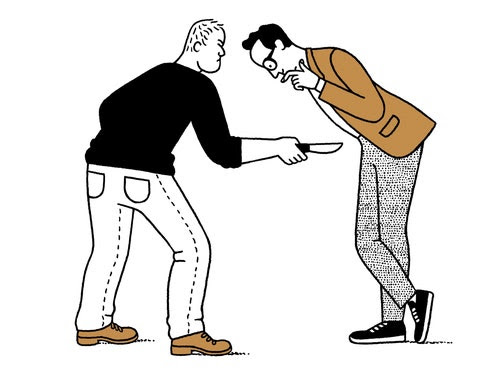 Shouts & Murmurs Shouts & MurmursReading Body Language Like the ExpertsOne raised eyebrow means that you’re intrigued, while no eyebrows means that you’re in Blue Man Group. By Colin Nissan |
Humor from The New Yorker
We can understand so much about what people are communicating by simply paying attention to their physical cues. Let’s say that you’re walking down the street and pass a guy who raises his arm in the air, then swings a knife at you. Body-language-wise, he wants to stab you.
Or how about if you’re at work, and your boss calls you into her office, then takes a swipe at you with a knife? Well, that’s already two people who have tried to take you out.
Maybe you’re on a first date and the person seems pretty great so far. You’re starting to feel a physical attraction toward her but aren’t sure if it’s mutual, because she’s not waggling her tongue back at you, and it’s been more than a minute.
Another scenario: You’re at dinner, and someone at the table next to yours stands up, red-faced, and starts pounding his chest with his fist. At first, you assume that he must be choking. But after taking a minute to think more critically about his body language—he’s dead now. Don’t be afraid to trust your first instinct with this stuff.
Your eyebrows alone can communicate more than you realize. One raised eyebrow means that you’re intrigued, while two raised eyebrows means that you’re surprised, and no eyebrows means that you’re in Blue Man Group.
Blink too much at the poker table, and people might suspect that you have a great hand. Blink too little, and they might start to wonder if something is wrong, because the rest of you isn’t moving, either. Lucky for you, one of the other players has the presence of mind to call 911. A quick cat scan shows that you had a neurological episode, which the doctor later explains is just a fancy term for a stroke, or mini-stroke, in your case. Either way, if it had been left untreated, it could have been bad. Like, bad-bad.
VIDEO FROM THE NEW YORKER
Supernova: A Stock-Car Succession Story
To bond with someone, you may find yourself unconsciously mirroring his body language. When he shrugs, you shrug. He flips his hair; you flip yours. He says, “Stop that”; you say, “Stop that.” He says, “I’m an idiot.” You say, “I’m an idiot”—and that’s how quickly you can get burned by body language.
When your seatmate on a plane hogs the armrest, she is using body language to assert dominance. Though it’s not exactly the same, there are some animal species that display this behavior in the wild with their armrests.
What if you’re out on an investigation and knock on a suspect’s door to ask a few questions? You’ll need to read the suspect’s body language to see if he’s telling you the truth. Is the knife in his hand shaking because he’s nervous about something? He’ll be reading you, too, so it won’t be long before he figures out that you’re not really a cop, and that you made your badge out of a soup can.
If your parents and siblings go away on vacation and leave you home alone to fend off a couple of bumbling thieves, all you can really do in terms of body language is place your hands on your cheeks and make a face like What am I supposed to do here? I’m eight.
Smiling is a powerful nonverbal tool. It’s a way of saying, “I’m really happy for you, Alex. Like, genuinely happy that you moved on, because you’re a good person, and we both knew this wasn’t working. It wasn’t a me thing or a you thing, it was an us thing. So I guess what I’m trying to say is, Good for you for bringing a date to our friend’s wedding two weeks after we broke up, you fucking sociopath.”
When you’re at Burger King and order a Whopper Jr., then see that they charged you for a regular Whopper, there has to be some great body language you could use there.
As helpful as body language can be with stabbings, it’s not an exact science. In fact, it’s not a science at all—it’s a language, and like all languages it can be misinterpreted. If you’ve ever asked where the bathroom is in Spanish and ended up getting a colonoscopy, you know exactly what I mean. ♦





